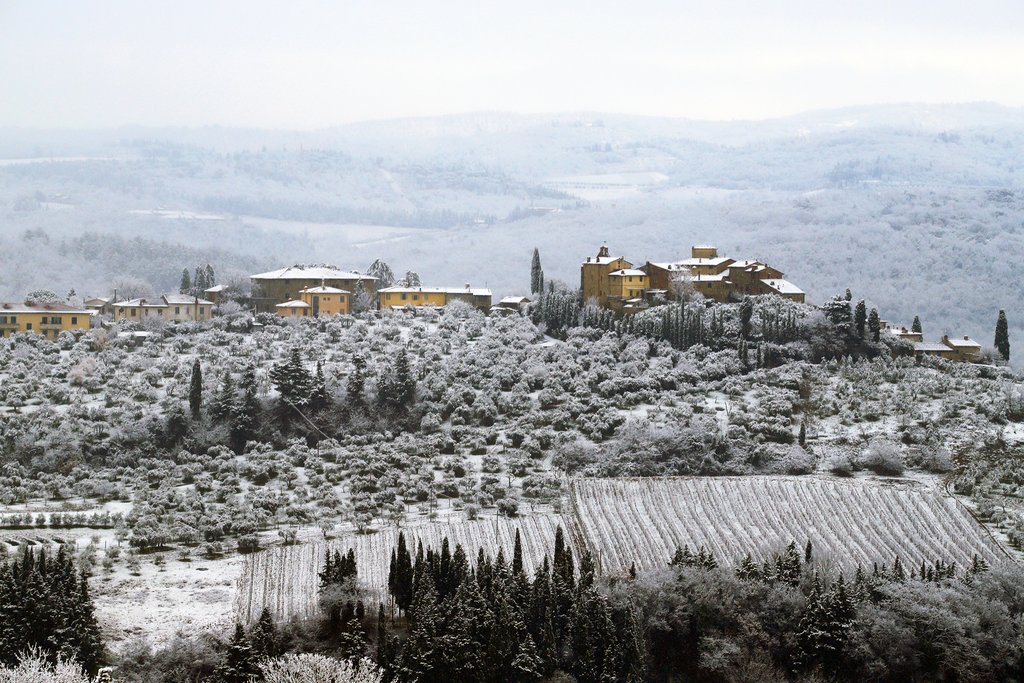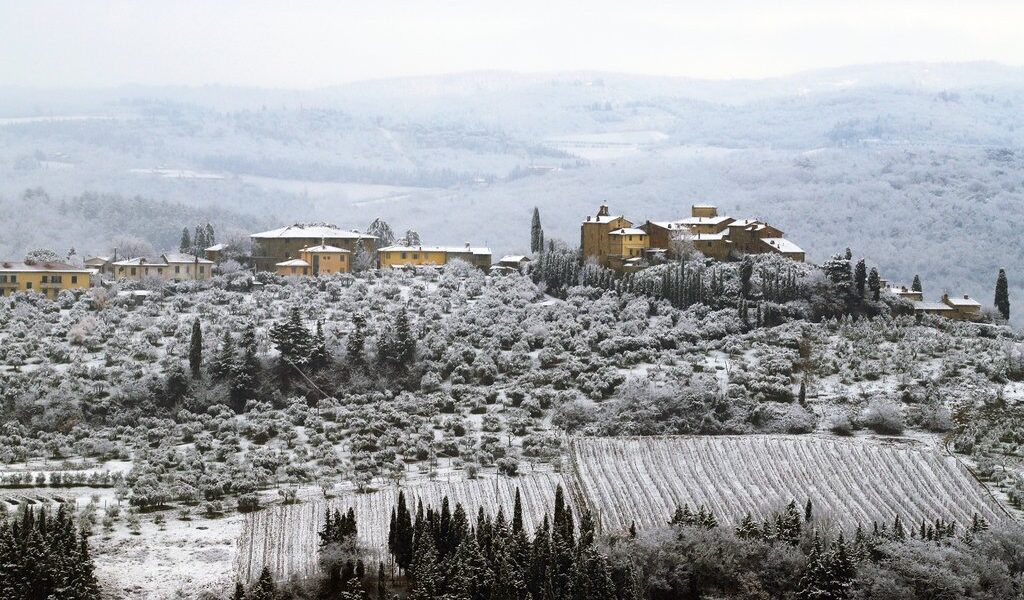
February is the last full month of winter in Tuscany, offering plenty of snowy adventures and lively festivals, as well as fewer tourists and lower prices. Ski season is well underway in the mountains, the resorts and their respective slopes bustling with activity. Meanwhile, the rest of the country celebrates the coming of spring with Lent and one of Italy’s liveliest religious events: Carnevale.
## Discover Tuscany in February: A Comprehensive Guide
February in Tuscany offers a unique travel experience, distinct from the bustling summer months. While the weather may be cooler, the rewards are plentiful: fewer crowds, lower prices, and a chance to witness authentic Tuscan traditions. This guide provides a detailed look at what to expect and how to make the most of your visit during this enchanting time of year.
**Weather in February**
Prepare for a range of temperatures when visiting Tuscany in February. As the second coldest month, closely following January, the average temperatures typically fluctuate between 37-55°F (3 C-13°C) across the region. In Florence, you can expect similar conditions, with temperatures hovering around 36-55°F (2 C-12°C). However, it’s crucial to remember that these are just averages.
The weather along the Tyrrhenian coast tends to be milder compared to inland areas, with slightly warmer temperatures. However, this coastal region also experiences a bit more rainfall. Conversely, the hilly regions, particularly in southern Tuscany, can be considerably colder, with temperatures frequently lingering around the freezing point.
For those seeking winter sports, the Apennine mountains offer ideal conditions. Expect even colder temperatures in this area, coupled with plentiful snowfall, making it a popular destination for skiing and snowboarding enthusiasts. The mountain resorts welcome visitors with open arms, providing thrilling opportunities to hit the slopes.
**Crowds and Costs: The Benefits of Off-Season Travel**
One of the most significant advantages of traveling to Tuscany in February is the noticeable absence of large crowds. The less favorable weather conditions tend to deter many tourists, resulting in a more relaxed and intimate experience. This also translates to significantly reduced prices on both airfare and accommodations, making it a budget-friendly time to visit.
However, there are exceptions to this rule. Mountainous areas boasting ski resorts experience a surge in popularity during February, as it’s considered the high season for winter sports. If you’re planning a ski or snowboard holiday, it’s imperative to book your accommodations, lift tickets, and any necessary equipment rentals well in advance to secure your spot.
February also marks the beginning of spring-related festivities, such as Mardi Gras and Carnivale. The exact timing of these events depends on the Catholic calendar, so be sure to check the dates before finalizing your travel plans. These celebrations can impact availability and prices in certain areas.
It is also worth noting that many hotels, restaurants, and bars in coastal towns and on the islands may be closed for the off-season. While you’ll always find some establishments open to cater to visitors, the choices will be more limited. Ferries to the islands may also operate on a reduced schedule, so carefully research your transportation options.
**Where to Go: Unveiling Tuscan Gems**
Tuscany in February offers a diverse range of experiences, from vibrant carnivals to tranquil chocolate valleys.
If your visit coincides with Italy’s Carnivale celebrations, prepare for an explosion of color and exuberance. These festivities typically last for weeks, offering ample opportunity to immerse yourself in the local culture. Consider a trip to Viareggio, located on the Versilia coast, which hosts one of Italy’s most spectacular pre-Lent celebrations. Expect to be amazed by massive floats carrying hundreds of costumed participants and elaborate papier-mâché caricatures. Beyond the parade along the Viali a Mare, the town organizes masked balls, sporting events, and musical performances, and restaurants create special carnival-themed menus. Alternatively, experience the charm of the smaller-scale Foiano della Chiana carnival outside of Arezzo, one of the oldest carnivals in Italy.
For a more romantic getaway (or for serious chocolate aficionados), embark on a delightful journey through the Chocolate Valley. This area, nestled between the provinces of Pisa, Pistoia, and Prato, is home to some of Italy’s most talented master chocolatiers. Indulge in delectable creations at Amedei in Pontedera, Slitti in Monsummano Terme, and Pasticceria Mannori in Prato. If your trip coincides with a chocolate-themed event like Florence and Chocolate, be sure to treat yourself to some seriously delicious treats!
To navigate efficiently between these destinations, rely on the reliable train network or consider renting a car. These options offer greater convenience and flexibility compared to other forms of public transportation.
**What to Do: Embracing Winter Activities and Beyond**
Shopping enthusiasts will be delighted to know that February marks the end of the annual winter sales period in Italy. This is a fantastic opportunity to find incredible deals on fashionable items at boutiques and retail stores in major cities like Florence and Siena. Keep an eye out for signs displaying the word *saldi* (sales) in store windows.
While Tuscany may not be as renowned for skiing as its northern Italian counterparts, the region offers surprisingly favorable conditions, milder weather, fewer crowds, and reasonably priced passes. Consider hitting the slopes of Monte Amiata in southern Tuscany for a unique skiing experience. From the summit of this extinct volcano, you can admire the stunning Sienese hills and enjoy panoramic views over the Maremma towards the Tyrrhenian Sea.
For those who prefer alternatives to skiing, there are numerous other winter sports to enjoy when there is snow on the ground, including sledding, snowshoe trekking (both during the day and at night), and ice skating. Nordic skiing is also a great choice; the Marsiliana-Macinaie route on Monte Amiata winds through Europe’s largest beechwood forest. If you prefer indoor activities, unwind by a cozy fireplace with a warming cocktail in one of Tuscany’s many ski resorts and savor the picturesque views of the Apennines.
If relaxation is your priority, take advantage of Tuscany’s numerous natural hot springs. Immerse yourself in the therapeutic waters of Saturnia, located in the heart of the wild Maremma, or visit Bagni San Filippo at the foot of Monte Amiata. Another option is Bagno Vignoni, situated in the picturesque Val d’Orcia.
**Events in February: A Calendar of Festivities**
**Carnevale:** This major event, held annually 40 days before Easter, brings vibrant festivities to cities and towns throughout Italy. The celebrations occur sometime between January and April, frequently falling in February.
**Brunello Crossing:** This annual weekend event in Montalcino caters to trail runners of all abilities. Nestled between Val d’Orcia and the Valle dell’Ombrone, the route meanders through woods, ancient pilgrimage routes, and the Sienese hills, with stops at vineyards along the way to sample Rossi di Montalcino. This race takes place the weekend before Benvenuto Brunello.
By planning ahead and embracing the unique characteristics of February, you can create unforgettable memories in the heart of Tuscany. From the vibrant Carnivale celebrations to the tranquil beauty of the Tuscan countryside, February offers a truly authentic Italian experience.
B-1368

